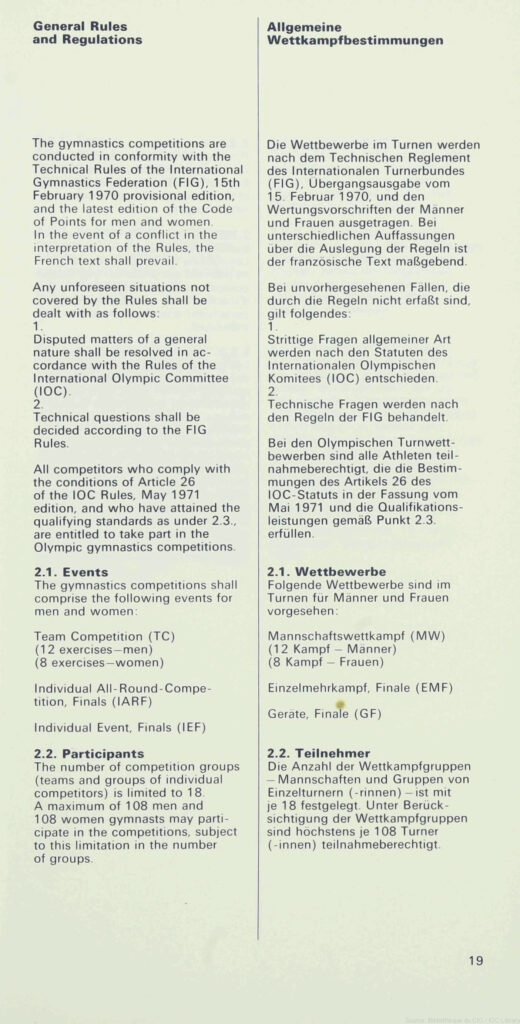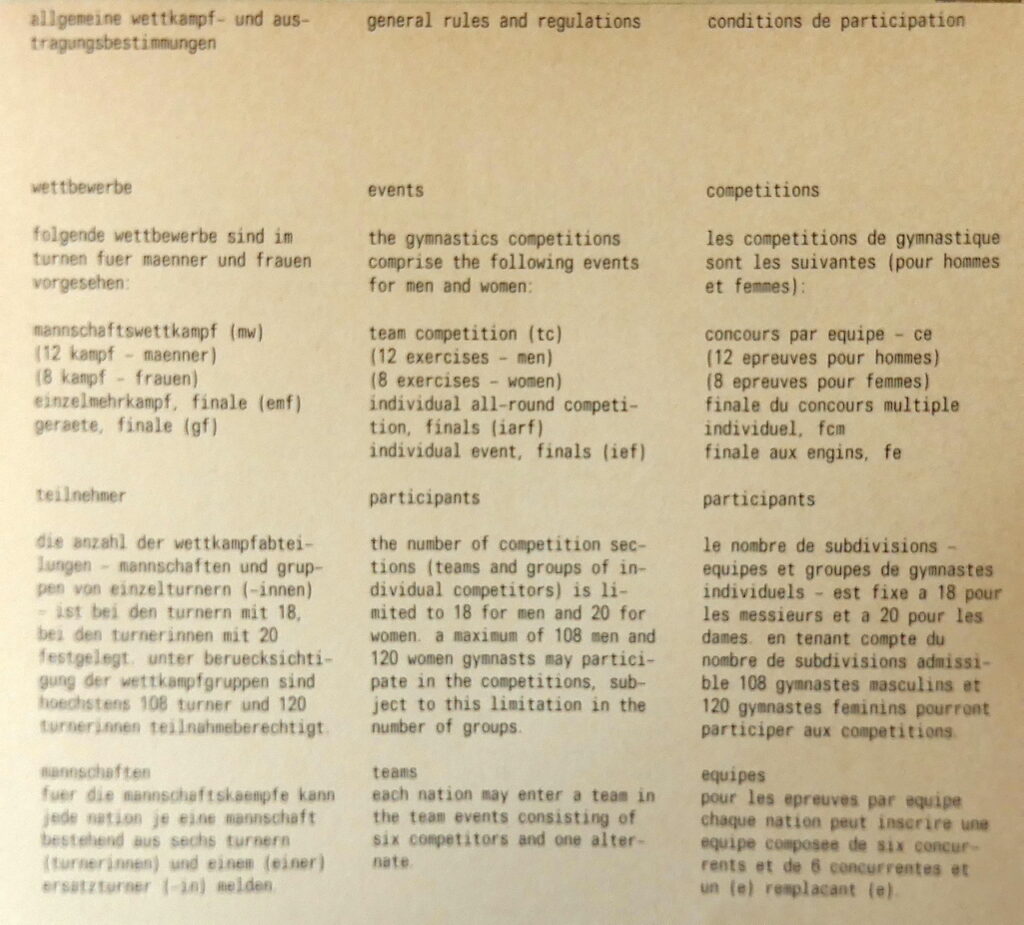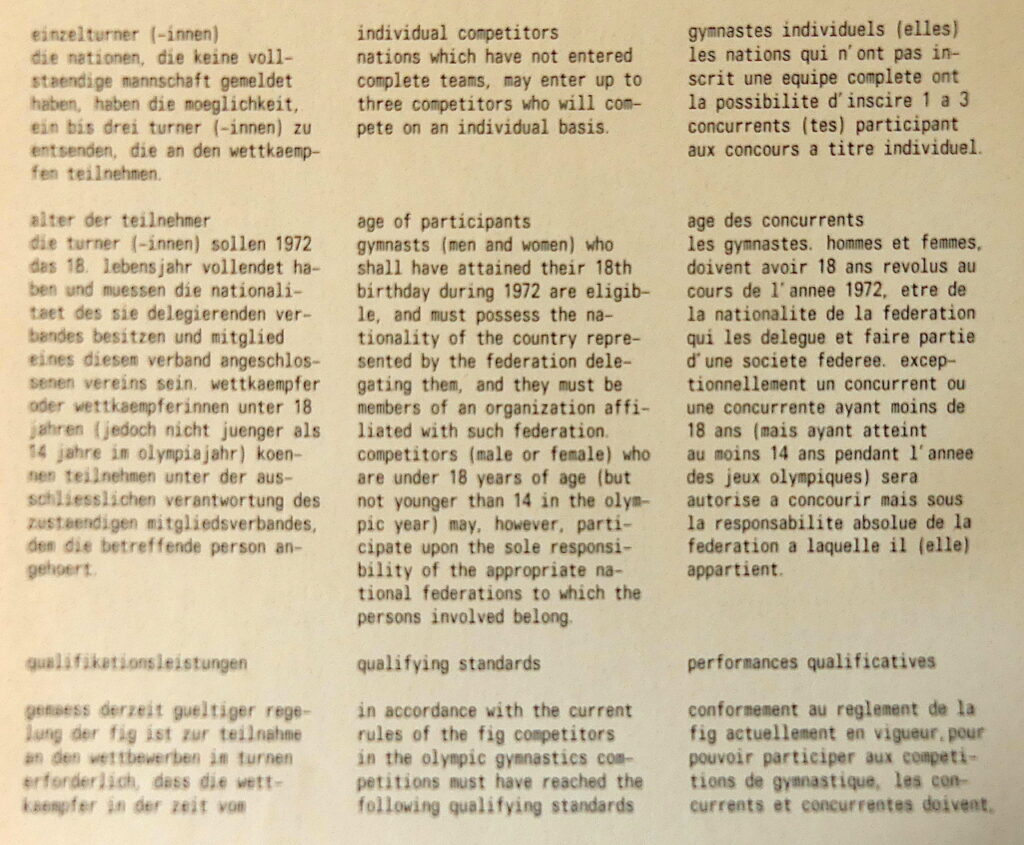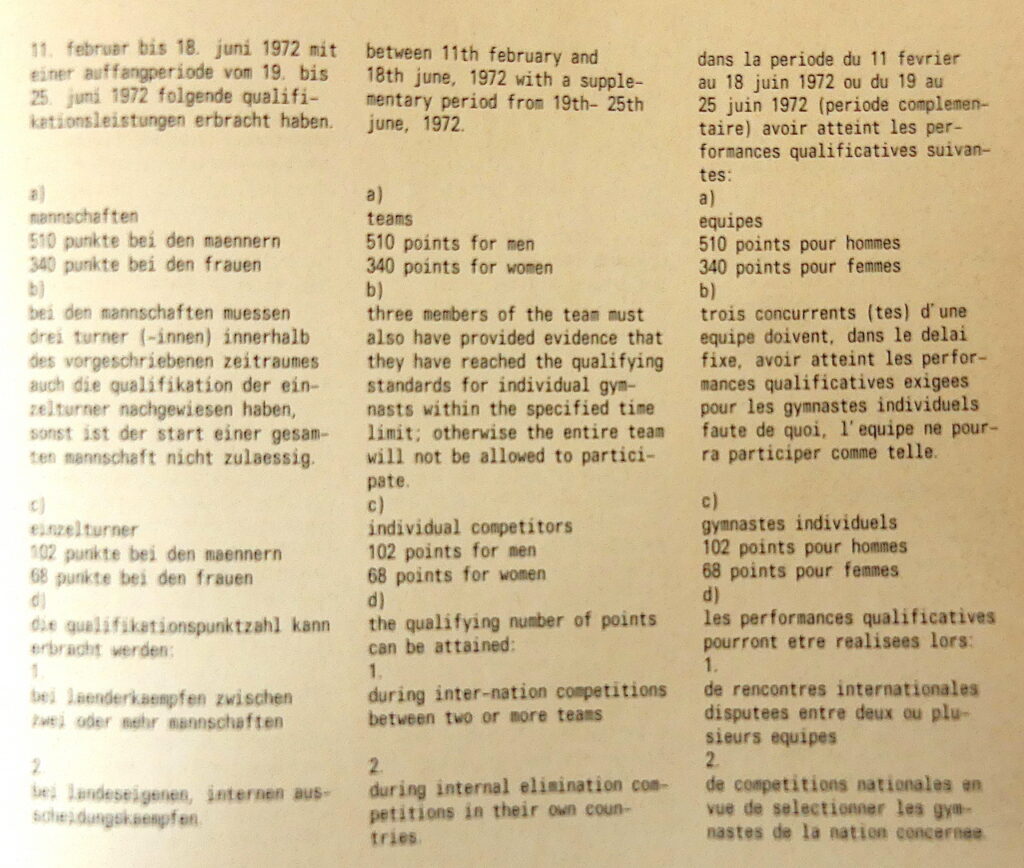A qualification system was put in place for the Munich Olympic Games. Countries had to achieve specific scores during a set period in order to participate in the Olympic Games.
Here were the rules guiding the process.

The Quotas
The number of competition groups (teams and groups of individual competitors) is limited to 18.
A maximum of 108 men and 108 women gymnasts may participate in the competitions, subject to this limitation in the number of groups.
Each nation may enter a team in the team events consisting of six competitors and one alternate.
Nations which do not wish or are unable to enter complete teams, may send up to three competitors who will compete on an individual basis.
Regulations for the Games of the XXth Olympiad, Munich 1972: Gymnastics
Gymnasts had to be over 14. But gymnasts who were under 18 were the sole responsibility of the national federations.
Gymnasts (men and women) who shall have attained their 18th birthday during 1972 are eligible, and must possess the nationality of the country represented by the federation delegating them, and they must be members of an organization affiliated with such federation. Competitors (male or female) who are under 18 years of age (but not younger than 14 in the Olympic year) may, however, participate upon the sole responsibility of the appropriate national federations to which the persons involved belong (Article 13 of the Technical Rules, 1970 provisional edition).
Regulations for the Games of the XXth Olympiad, Munich 1972: Gymnastics
The Qualifying Standards
In accordance with the FIG decision of 31st July, 1971, competitors in the Olympic gymnastics competitions must have reached the following qualifying standards between 11th February and 18th June, 1972 with a supplementary period from 19th – 25th June, 1972:
a) Teams:
510 points for men
340 points for womenb) three members of the teams must also provide evidence that they have reached the qualifying standards for individual gymnasts within the specified time limit: otherwise, the entire team will not be allowed to participate
c) Individual competitors
102 points for men
68 points for womend) the qualifying number of points can be attained:
Regulations for the Games of the XXth Olympiad, Munich 1972: Gymnastics
1. during inter-nation competitions between two or more teams
2. during internal elimination competitions in their own countries.
Neutral judges were not mentioned in the rules, but they were required.
The U.S. men, for example, used their Olympic Trials as the qualifying competition. Here were their neutral judges:
Mr. Arthur Gander, president, F.I.G., appointed Mr. Albert Dippong from Canada as superior judge, who has demonstrated great skill and knowledge during the entire competition. The two neutral judges were Mr. Hartmut Fink and Mr. Eugene Oryshchyn, also from Canada.
Frank Cuminskey and Les Sasvary were the American judges who will also represent the U.S. in Munich, Germany. We found out later on that this group was a truly great representation of international judges. Dippong was born in Zombor, Yugoslavia, formerly a Hungarian territory (he speaks fluent Hungarian, by the way). Hartmut was from Germany, Oryshchyn from Poland (emigrated to Canada around 1960), and Sasvary was born in Hungry [sic].
Gymnast, June/July 1972
For many countries, it gave them the opportunity to show off their routines to the Olympic judges early in the year.
For example, Sylvia Hlavacek would be a judge at the 1972 Olympics, and during one of Hungary’s qualifying meets, Hlavacek had this to say:
Sylvia Hlavacek, the other judge from the GDR, added to what was said, what an aesthetic sight all the members of this team are, they are beautiful, young, and in great shape. “They make an extremely good impression,” she emphasized, “and as I watched them, there can be no problem with the team spirit either! I give them very good chances for the Munich Olympics…”
Népsport, May 23, 1972
Sylvia Hlavacek, az NDK-ból érkezett másik pontozóbíró az elmondottakhoz már csak annyit tett hozzá, milyen esztétikus látvány ennek a csapatnak valamennyi tagja, szépek, fiatalok, remek alkatúak. „Rendkívül jó benyomást keltenek — hangsúlyozta —, s ahogy figyeltem őket, a csapatszellemmel sem lehet baj! Én a müncheni olimpiára nagyon szép esélyeket adok nekik …”
There were those who lamented the use of the qualification standards.
For example, Arthur Magakian, National Technical Director of the French Gymnastics Federation, wrote the following after the Olympics:
16 teams only, 68 nations affiliated to the FIG, what about the absence of Finland (bronze medal in ’48, 3rd in ’52 and ’56, 6th in 1960, 8th in ’64, 16th in ’68)?
From Sweden, Norway, Denmark, or all the Nordic countries?
Absences also from Algeria, Morocco, Tunisia, Turkey, UAR, Lebanon, all South American countries, South Korea, etc.
The Olympic Games should represent the competition of all the best individuals in the world. The qualification system needs to be completely overhauled. As is the case in athletics, each nation must be entitled to one gymnast at the Olympics.
Revue EP&S, November-December, 1972
16 équipes seulement, 68 nations affiliées à la FIG, que penser de l’absence de la Finlande (médaille de bronze en 48 , 3e en 52 et en 56, 6e en 1960 , 8e en 64 , 16e en 68)?
De la Suède, de la Norvège, du Danemark, soit de tous les pays nordiques ?
Absences également de l’Algérie, du Maroc, de la Tunisie, de la Turquie, de la RAU, du Liban, de tous les pays d’Amérique du Sud, de la Corée du Sud, etc.
Les Jeux Olympiques devraient représenter la compétition de toutes les meilleures individualités du monde. Le système de qualification est à revoir complètement. Comme c’est le cas en athlétisme, chaque nation doit avoir droit à un gymnaste aux J.O.
Note: Since Magakian referred to track and field, here were the rules for participating in track and field (i.e. athletics) in 1972:
Every country is entitled to enter one competitor for each event regardless of the required minimum standards as mentioned below.
In addition, every country can enter two more competitors but in this case all participatns, including the first one, shall have attained the required minimum standards.
Every country may enter up to three participants in the marathon race and in the 20 km and 50 km walks; minimum standards are not required.
Regulations of the XXth Olympiad, Munich 1972: Athletics
Download
Here are the same instructions in a different format (via Hardy Fink):



One reply on “1972: The Qualification Criteria for Gymnastics at the Munich Olympics”
Interesting to see my name (one of the neutral judges at the USA Olympic Trials) as Hartmut Fink still at that time though I started using Hardy about two years earlier.